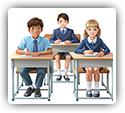Chiropractic Helps Improve Academic Performance in Dyslexic Students
Print Article

The 2025 second-quarter issue of the Asian Pacific Chiropractic Journal published the results of a case series documenting the chiropractic care of three students diagnosed with dyslexia and struggling with learning disabilities.
According to this study, "Dyslexia is a neurobiological learning disability, defined by word recognition difficulty and poor spelling abilities despite normal intelligence and adequate education and exposure to written material." Estimates vary by authority, but it is commonly believed that between 5% and 15% of the world’s population has some form of dyslexia.
This case series involved three students who were underperforming in school and had been diagnosed with dyslexia. The first student was a 9-year-old girl who had been diagnosed with dyslexia by her pediatrician. The second student was a 7-year-old girl who was diagnosed with dyslexia by her psychiatrist. The third student was a 15-year-old boy with no formal diagnosis of dyslexia but who was struggling with academic performance in school.
These students were all expressing a variety of symptoms associated with dyslexia including poor long-term and short-term memory, poor concentration, struggling with reading, writing and spelling, as well as difficulty retaining information, and a lack of motivation for learning.
Each of these students received a comprehensive chiropractic and neurological examination. All three started specific forms of chiropractic care in addition to other forms of brain and neurological therapies.
The study documents that each of the three students experienced improvements in their various symptoms. These improvements included better concentration, improved reading including reading out loud, better comprehension, more motivation for learning, and a noticeable improvement in memory. One of the student teachers even reported that her student had improved 5 levels of reading within 1 term. Another student became more talkative, more willing to accept challenges, showed improved handwriting, began enjoying homework, and was generally happier.
All three students involved in this case series saw various improvements with their dyslexia symptoms. They authors explained "Case 1 and 2 student subjects were both diagnosed with specific learning disability with impairment in reading (Dyslexia) under DSM-5 criteria. Case 3 student was not formally diagnosed, but was identified by his school as struggling in academic performance." They concluded, "A 12-week treatment program yielded significant improvement in reading levels, learning behavior as well as academic grades across all subjects."
Print Article


